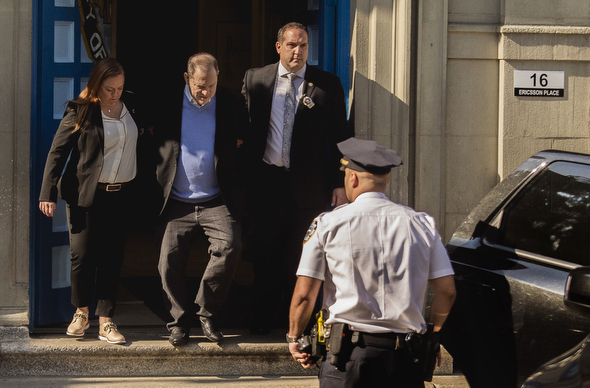What do we do with the work left behind by artists named as #MeToo offenders?

What are fans to do after their favorite celebrities’ tarnished pasts are brought to light?
Last week, Morgan Freeman was accused by eight people of unwanted touching and other inappropriate behavior. The allegations, which Freeman has denied, put the Oscar-winning actor among a notable group of entertainers.
These include comedian Bill Cosby—who was last month found guilty of sexual assault—actor Kevin Spacey, and producer Harvey Weinstein, who was charged last week with rape, committing a criminal sex act, sexual abuse, and sexual misconduct.
Since April 2017, more than 200 powerful people, among them some of our most celebrated performers, have been accused of sexual misconduct.
Can we separate our appreciation of the art from our condemnation of an artist’s violent abuses of his power while he was making it, or should we include this new knowledge in our assessment of the work?
Northeastern philosophy professors Sheila Winborne and Candice Delmas have given considerable thought to this dilemma in the wake of #MeToo. They believe that the sexual misconduct at the center of the #MeToo and #TimesUp campaigns is pervasive in virtually every profession and has been throughout history.
“To ensure with certainty that we aren’t watching works created by someone who abused his power, we’d perhaps have to stop watching almost everything,” said Winborne, a religious studies scholar who teaches interdisciplinary courses in religion, philosophy, and film.
The influential Renaissance artist Caravaggio is believed to have murdered a pimp; French post-impressionist painter Paul Gauguin abandoned his family and moved to Tahiti, where he took three native brides aged 13 to 14, infecting them and countless other local girls with syphilis; Beat Generation icon William Burroughs killed his wife in a drunken game; and rapper Tupac Shakur was convicted of the sexual assault of a 19-year-old woman.
“Our museums and libraries are filled with great art made by bad people,” said Delmas, associate director of the Politics, Philosophy, and Economics program.
Boycott or not?
Grappling with the work of living artists who have been accused of sexual misconduct requires its own sort of reckoning. In doing so, Delmas said there are two questions to consider.
“One is whether we should continue consuming the work, all the while morally condemning the author’s conduct. The other is whether moral condemnation of the person should affect our judgment of their work,” she said.
Delmas believes there are strong arguments in favor of boycotting the work of people accused of sexual harassment or assault. By doing so, we are making known our moral condemnation of the accused, distancing ourselves from their work, and potentially ensuring we’re not contributing to their financial success, she said.
Even when it doesn’t, “a disposition to boycott still seems to me morally desirable,” Delmas said. “But I recognize that this can be a tall moral order given—sadly—how little would be left for us to enjoy guilt-free.”
Boycotts have a downside, though.
“For instance, boycotting films produced by Miramax to punish Harvey Weinstein would affect the economic interests of many of his victims,” who were also involved with, and paid for their work in those films, Delmas said.
Or, the work might have great value, despite the reprehensible past of its creator.
“A sexual predator may well have created a masterpiece, something that enriches our life, or made a great discovery that can save people’s lives,” Delmas said. “In cases like these, we might find that the work’s value outweighs the reasons we have for wanting to demote the work to obscurity.
“People—societies—have to decide for themselves how to weigh these variables and solve these dilemmas,” she said.
‘This is a systemic problem’
Winborne is not suggesting that boycotting the work of accused sexual abusers will solve the root causes of sexual misconduct.
What might help, though, is better education about the subtle, often unconscious messages presented in films and other cultural institutions, Winborne said.
Winborne calls on her students to be more conscious about how messages are communicated, and just as importantly, to notice which messages are communicated the most.
“Often, I’ll ask my students what they’ve learned about gender through Disney films,” she said. “I’ve never had a student say they hadn’t learned anything. From Disney to horror films and everything else, messages are often embedded that reinforce cultural stereotypes.” Winborne said.
This creates a sort of cultural feedback loop, within which movies both reflect cultural stereotypes—such as the stereotype that men are more powerful than women—and help reinforce those stereotypes as normal behavior.
Winborne said that most people unconsciously accept these stereotypes to some degree. “They see them represented so often and have never been taught to analyze and consider critically how media reflect and influence the things we believe and the way we act,” she said.
“We need women and men who support women’s rights as basic human rights to call for more ethical approaches behind the camera and more diversity in leadership,” Winborne said.
Viewers, too, need to be discerning and critical toward what they are watching.
That doesn’t mean we can’t enjoy movies.
Instead, Winborne argues, conscious analysis “can result in shifts in how we understand our relationships to media entertainment business produces and the influences of their creators on our world views,” she said.
That may not help with the decision of whether or not to watch Fat Albert, Frida, or Unforgiven. But if we do return to the works of discredited artists and entertainers, at least we can try to separate what we’re watching from how we feel about the people who made it.





